中国菜名的翻译策略
中国菜名官方翻译原则
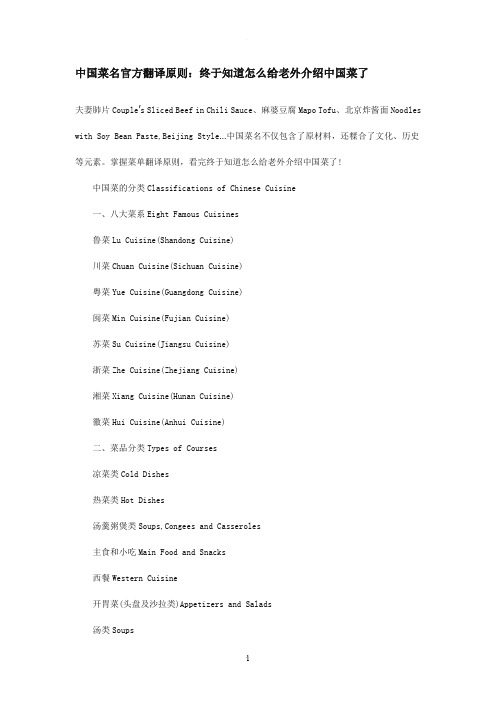
中国菜名官方翻译原则:终于知道怎么给老外介绍中国菜了夫妻肺片Couple’s Sliced Beef in Chili Sauce、麻婆豆腐Mapo Tofu、北京炸酱面Noodles with Soy Bean Paste,Beijing Style…中国菜名不仅包含了原材料,还糅合了文化、历史等元素。
掌握菜单翻译原则,看完终于知道怎么给老外介绍中国菜了!中国菜的分类Classifications of Chinese Cuisine一、八大菜系Eight Famous Cuisines鲁菜Lu Cuisine(Shandong Cuisine)川菜Chuan Cuisine(Sichuan Cuisine)粤菜Yue Cuisine(Guangdong Cuisine)闽菜Min Cuisine(Fujian Cuisine)苏菜Su Cuisine(Jiangsu Cuisine)浙菜Zhe Cuisine(Zhejiang Cuisine)湘菜Xiang Cuisine(Hunan Cuisine)徽菜Hui Cuisine(Anhui Cuisine)二、菜品分类Types of Courses凉菜类Cold Dishes热菜类Hot Dishes汤羹粥煲类Soups,Congees and Casseroles主食和小吃Main Food and Snacks西餐Western Cuisine开胃菜(头盘及沙拉类)Appetizers and Salads汤类Soups副菜Entrées主菜Main Courses配菜Side Dishes甜点Desserts饮品Drinks一、酒精类饮品Alcoholic Beverages国酒Chinese Wines洋酒Imported Wines白兰地与威士忌Brandy and Whisky金酒与朗姆酒Gin and Rum伏特加与龙舌兰Vodka and Tequila利口酒和开胃酒Liqueurs and Aperitifs红酒Red Wine二、不含酒精类饮品Non-Alcoholic Beverages三、中国饮品文化Chinese Drinking Culture中国茶文化Chinese Tea Culture中国酒文化Chinese Wine Culture中国菜名的翻译原则以主料为主,配料或配汁为辅的翻译原则1.菜肴的主料和配料主料(名称/形状)+with+配料如:松仁香菇Chinese Mushrooms with Pine Nuts2.菜肴的主料和配汁主料with/in+汤汁(Sauce)如:冰梅凉瓜Bitter Melon in Plum Sauce以烹制方法为主,原料为辅的翻译原则1.菜肴的做法和主料做法(动词过去分词)+主料(名称/形状)如:拌双耳Tossed Black and White Fungus2.菜肴的做法、主料和配料做法(动词过去分词)+主料(名称/形状)+配料如:豌豆辣牛肉Sautéed Spicy Beef and Green Peas3.菜肴的做法、主料和汤汁做法(动词过去分词)+主料(名称/形状)+with/in+汤汁如:川北凉粉Tossed Clear Noodles with Chili Sauce以形状、口感为主,原料为辅的翻译原则1.菜肴形状或口感以及主配料形状/口感+主料如:玉兔馒头Rabbit-Shaped Mantou脆皮鸡Crispy Chicken2.菜肴的做法、形状或口感、做法以及主配料做法(动词过去分词)+形状/口感+主料+配料如:小炒黑山羊Sautéed Sliced Lamb with Pepper and Parsley 以人名、地名为主,原料为辅的翻译原则1.菜肴的创始人(发源地)和主料人名(地名)+主料如:麻婆豆腐Mapo Tofu(Sautéed Tofu in Hot and Spicy Sauce)广东点心Cantonese Dim Sum2.介绍菜肴的创始人(发源地)、主配料及做法做法(动词过去式)+主辅料+人名/地名+Style如:四川辣子鸡Spicy Chicken,Sichuan Style北京炸酱面Noodles with Soy Bean Paste,Beijing Style体现中国餐饮文化,使用汉语拼音命名或音译的翻译原则1.具有中国特色且被外国人接受的传统食品,本着推广汉语及中国餐饮文化的原则,使用汉语拼音。
浅析中国菜名的准确英译

浅析中国菜名的准确英译陈思(2012418287)翻译学院翻译专业摘要:中国饮食文化历史悠久,博大精深,大型纪录片《舌尖上的中国》热播也引发中国美食追根溯源的讨论。
近几年,越来越多的外国人到中国并对中国菜感兴趣。
因此,中式菜肴也是传播中华文化的一种载体。
如何正确恰当的翻译中国菜名在传播中华文明方面起到直观重要的作用。
中国是一个有着悠久历史的国家,饮食文化是中国悠久历史的重要组成部分,其内容丰富,博大精深。
改革开放以来,越来越多的有着不同文化背景的人来到中国,并对中国菜很感兴趣。
外国朋友在品尝中国美食的同时,常常好奇和渴望知道中国一些菜名的由来、起源和其真正的含义。
中国菜的名字作为一个窗口,实际上是用一个有效手段来告知外国人中国的一些文化背景。
因此,重视菜肴的准确应以在传播中华饮食文化上起到了重要的作用。
1.中国菜名的特征由于中国菜的多样化,中国菜名字的特征区别于其他任何一个国家,无论是从语言学还是从文化层面。
1.1从语言学观点1.1.1经常使用缩写中国菜的特点结合许多配料和调味料在一个单一的食物中,那样经常会出现很难用很短的名字去呈现出包含所有材料的情况。
从而缩写名字通常是首选。
“豆豉炒三鲜”,中国人觉得这些食物食物无论是单独或者搭配在一起都是上佳口味,鲜美可口。
有烹饪方法和食物材料组成名字,简明易懂,并且传达出了食物的特性。
在翻译时应同时传达出这种思想。
在网上有众多关于炒三鲜的英译,最为普遍的是Mix seafood with black bean sauce。
这种翻译方法突出了三鲜的种类,简明扼要。
相传周武王在庆功宴上犒劳他八个伐纣有功的大臣,所以食物取名八宝饭。
正宗的八宝饭由糯米、豆沙、枣、葡萄干、苹果干、蜜瓜、莲子、杏干、枸杞、山楂肉、猪油、白糖、淀粉做成。
成品八宝饭应该是晶莹透亮、香甜可口。
而翻译时应译出的口味而不是八个大臣。
1.1.2 经常使用四字格式在中国很喜欢用数量的音节在同一个词或者短语中他们是有两个音节或者两个双音节组成四字词语,这样让人感到整齐,圆满。
从翻译的目的论看中式菜肴英译的翻译策略

从翻译的目的论看中式菜肴英译的翻译策略一、本文概述在全球化的大背景下,中式菜肴作为中华文化的瑰宝之一,正逐渐走向世界舞台,其英译问题也随之凸显。
中式菜肴的翻译不仅仅是语言文字的转换,更是文化内涵的传递。
现有的翻译策略往往忽视了菜肴背后的文化内涵和翻译的目的,导致翻译效果不尽如人意。
有鉴于此,本文将从翻译的目的论视角出发,探讨中式菜肴英译的翻译策略。
本文首先将回顾翻译目的论的基本原理,并分析其在菜肴翻译中的应用价值。
本文将通过对现有中式菜肴英译实例的分析,总结当前翻译中存在的问题和挑战。
在此基础上,本文将提出一套基于翻译目的论的中式菜肴英译策略,旨在更好地传递中式菜肴的文化内涵,促进中华饮食文化的国际传播。
本文的研究不仅有助于提升中式菜肴英译的质量,还能为其他文化产品的翻译提供借鉴,具有一定的理论意义和实践价值。
二、中式菜肴的文化特性与翻译难点中式菜肴作为中国传统文化的重要组成部分,其独特的文化内涵和制作工艺在全球范围内享有盛誉。
在将其翻译成英语的过程中,翻译者面临着多重难点,这些难点不仅涉及语言的转换,更触及到文化的传递和接受。
中西文化在饮食习惯、食材选择、口味偏好等方面存在显著差异。
例如,中文中的“红烧肉”直接翻译为“redcooked pork”可能无法让英语读者准确理解其烹饪方法和口味特点。
翻译者需要在保持原文文化特色的同时,尽可能地使目标语言读者能够理解和接受。
中式菜肴的食材和制作工艺复杂多样,许多特定的食材和制作手法在英语中没有直接对应的词汇。
如“豆芽”在英语中为“bean sprout”,但“豆苗”则没有直接对应的翻译,需要额外解释。
一些独特的烹饪技巧,如“炒”、“炖”、“蒸”等,虽然在英语中有对应词汇,但所表达的烹饪程度和方式可能与中文原意有所出入。
中式菜肴往往蕴含着丰富的文化意义和历史故事。
例如,“宫保鸡丁”不仅仅是一道菜,其背后还有着与清朝官员丁宝桢相关的故事。
在翻译时,如何在不牺牲原有文化内涵的前提下,使外国读者理解并欣赏这些文化元素,是一个巨大的挑战。
中国菜名官方翻译原则
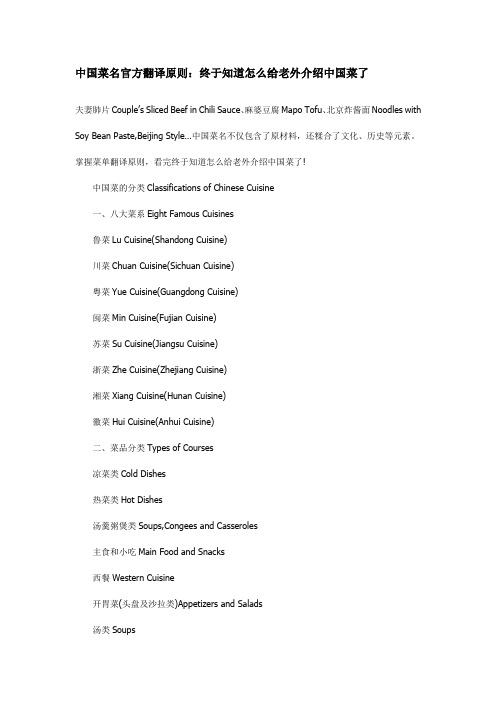
中国菜名官方翻译原则:终于知道怎么给老外介绍中国菜了夫妻肺片Couple’s Sliced Beef in Chili Sauce、麻婆豆腐Mapo Tofu、北京炸酱面Noodles with Soy Bean Paste,Beijing Style…中国菜名不仅包含了原材料,还糅合了文化、历史等元素。
掌握菜单翻译原则,看完终于知道怎么给老外介绍中国菜了!中国菜的分类Classifications of Chinese Cuisine一、八大菜系Eight Famous Cuisines鲁菜Lu Cuisine(Shandong Cuisine)川菜Chuan Cuisine(Sichuan Cuisine)粤菜Yue Cuisine(Guangdong Cuisine)闽菜Min Cuisine(Fujian Cuisine)苏菜Su Cuisine(Jiangsu Cuisine)浙菜Zhe Cuisine(Zhejiang Cuisine)湘菜Xiang Cuisine(Hunan Cuisine)徽菜Hui Cuisine(Anhui Cuisine)二、菜品分类Types of Courses凉菜类Cold Dishes热菜类Hot Dishes汤羹粥煲类Soups,Congees and Casseroles主食和小吃Main Food and Snacks西餐Western Cuisine开胃菜(头盘及沙拉类)Appetizers and Salads汤类Soups副菜Entrées主菜Main Courses配菜Side Dishes甜点Desserts饮品Drinks一、酒精类饮品Alcoholic Beverages国酒Chinese Wines洋酒Imported Wines白兰地与威士忌Brandy and Whisky金酒与朗姆酒Gin and Rum伏特加与龙舌兰Vodka and Tequila利口酒和开胃酒Liqueurs and Aperitifs红酒Red Wine二、不含酒精类饮品Non-Alcoholic Beverages三、中国饮品文化Chinese Drinking Culture中国茶文化Chinese Tea Culture中国酒文化Chinese Wine Culture中国菜名的翻译原则以主料为主,配料或配汁为辅的翻译原则1.菜肴的主料和配料主料(名称/形状)+with+配料如:松仁香菇Chinese Mushrooms with Pine Nuts2.菜肴的主料和配汁主料with/in+汤汁(Sauce)如:冰梅凉瓜Bitter Melon in Plum Sauce以烹制方法为主,原料为辅的翻译原则1.菜肴的做法和主料做法(动词过去分词)+主料(名称/形状)如:拌双耳Tossed Black and White Fungus2.菜肴的做法、主料和配料做法(动词过去分词)+主料(名称/形状)+配料如:豌豆辣牛肉Sautéed Spicy Beef and Green Peas3.菜肴的做法、主料和汤汁做法(动词过去分词)+主料(名称/形状)+with/in+汤汁如:川北凉粉Tossed Clear Noodles with Chili Sauce以形状、口感为主,原料为辅的翻译原则1.菜肴形状或口感以及主配料形状/口感+主料如:玉兔馒头Rabbit-Shaped Mantou脆皮鸡Crispy Chicken2.菜肴的做法、形状或口感、做法以及主配料做法(动词过去分词)+形状/口感+主料+配料如:小炒黑山羊Sautéed Sliced Lamb with Pepper and Parsley 以人名、地名为主,原料为辅的翻译原则1.菜肴的创始人(发源地)和主料人名(地名)+主料如:麻婆豆腐Mapo Tofu(Sautéed Tofu in Hot and Spicy Sauce)广东点心Cantonese Dim Sum2.介绍菜肴的创始人(发源地)、主配料及做法做法(动词过去式)+主辅料+人名/地名+Style如:四川辣子鸡Spicy Chicken,Sichuan Style北京炸酱面Noodles with Soy Bean Paste,Beijing Style体现中国餐饮文化,使用汉语拼音命名或音译的翻译原则1.具有中国特色且被外国人接受的传统食品,本着推广汉语及中国餐饮文化的原则,使用汉语拼音。
跨文化交际理论下的中国菜名英译研究

跨文化交际理论下的中国菜名英译研究跨文化交际理论下的中国菜名英译研究摘要:中国菜名在国内具有丰富的文化内涵和独特的特色,但是在跨文化交际中,由于文化差异和语言障碍,其英文翻译存在一定的困难。
本文将运用跨文化交际理论,结合对中国菜名的分类和翻译策略进行研究,探讨如何更好地进行中国菜名的英译。
关键词:跨文化交际,中国菜名,英译,文化差异,翻译策略一、引言中国菜以其丰富的烹饪技艺和文化内涵在世界范围内享有盛誉。
然而,由于文化差异和语言障碍,中国菜名在跨文化交际中的英译经常面临着一些困难。
中国菜名翻译涉及语言、文化和社会背景等多种因素,而这些因素之间的关系对于菜名的准确传达至关重要。
二、跨文化交际理论在菜名翻译中的应用跨文化交际理论认为,在不同文化之间的交流中,人们除了使用语言进行沟通外,还需要考虑到文化差异对交际的影响。
在中国菜名翻译中,也需要结合跨文化交际理论来进行分析和策略选择。
1. 文化差异对菜名翻译的影响中国菜名源于丰富的文化内涵,有些菜名与独特的风俗习惯和历史文化紧密相关。
在翻译过程中,需要更好地理解和传达这些文化背景,以确保翻译的准确性和完整性。
例如,著名的菜肴“麻婆豆腐”,直译为“Spicy Bean Curd”,无法传达麻辣的特点和其中蕴藏的故事,因此在英文菜单中可以选择更为生动的译名“Pockmarked Old Woman's Tofu”。
2. 菜名翻译策略的选择在菜名的翻译中,常见的策略有直译、意译和组词等。
对于不同的菜名,选择合适的翻译策略可以更好地传达其特点和文化内涵。
例如,对于以食材或烹调方法命名的菜品,可以选择直译的方式,如“酸辣汤”翻译为“Hot and Sour Soup”;对于带有文化背景的菜名,可以采用意译的方式进行翻译,如“宫保鸡丁”翻译为“Kung Pao Chicken”;对于较长的菜名,可以考虑使用组词的方式进行翻译,如“蚝油生菜”翻译为“Lettuce with Oyster Sauce”。
中餐菜名翻译研究综述
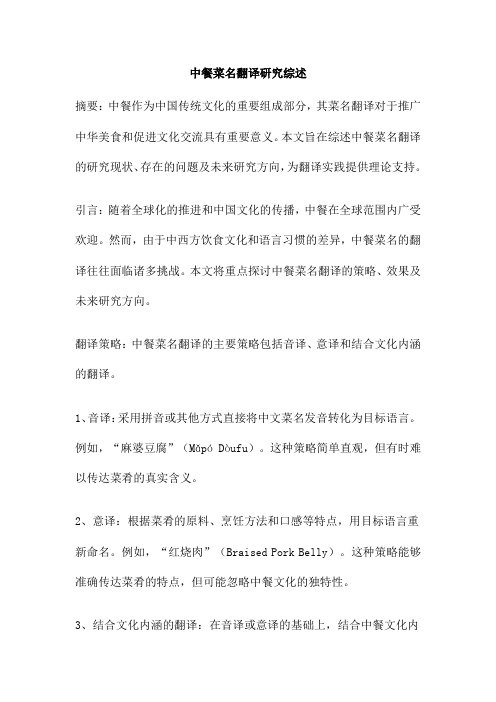
中餐菜名翻译研究综述摘要:中餐作为中国传统文化的重要组成部分,其菜名翻译对于推广中华美食和促进文化交流具有重要意义。
本文旨在综述中餐菜名翻译的研究现状、存在的问题及未来研究方向,为翻译实践提供理论支持。
引言:随着全球化的推进和中国文化的传播,中餐在全球范围内广受欢迎。
然而,由于中西方饮食文化和语言习惯的差异,中餐菜名的翻译往往面临诸多挑战。
本文将重点探讨中餐菜名翻译的策略、效果及未来研究方向。
翻译策略:中餐菜名翻译的主要策略包括音译、意译和结合文化内涵的翻译。
1、音译:采用拼音或其他方式直接将中文菜名发音转化为目标语言。
例如,“麻婆豆腐”(Mǎpó Dòufu)。
这种策略简单直观,但有时难以传达菜肴的真实含义。
2、意译:根据菜肴的原料、烹饪方法和口感等特点,用目标语言重新命名。
例如,“红烧肉”(Braised Pork Belly)。
这种策略能够准确传达菜肴的特点,但可能忽略中餐文化的独特性。
3、结合文化内涵的翻译:在音译或意译的基础上,结合中餐文化内涵进行翻译。
例如,“龙井虾仁”(Longjing Shrimp Meat)。
这种策略能够更好地保留中餐文化的特点,但要求译者对中餐和文化有深入了解。
翻译效果:中餐菜名翻译的效果主要体现在文化传播和餐饮业实际应用两方面。
1、文化传播方面:中餐菜名翻译是传播中国饮食文化的重要途径。
恰当的翻译策略能够保留中餐菜名的原始含义,同时传达出中国的饮食文化和价值观。
反之,不准确的翻译可能导致文化误解和信息传递失败。
2、餐饮业实际应用价值:中餐菜名翻译在餐饮业具有重要实际应用价值。
菜名的翻译应符合目标市场的语言习惯和审美需求,以吸引更多顾客。
同时,准确的菜名翻译有助于顾客更好地了解和选择菜品,提高餐饮服务质量。
存在的问题:当前中餐菜名翻译存在的主要问题包括翻译不准确、缺乏标准化和译者能力不足等。
1、翻译不准确:部分中餐菜名翻译无法准确传达菜肴的真实含义,甚至存在误导。
菜名翻译

中国菜名的英语翻译翻译中国菜名时,有一个固定公式,那就是:菜肴的主要成分 + with + 口味 + flavour为便于您理解,我举四个例子,请您看一看。
①醋溜土豆:主要成分是土豆,口味偏酸,因此译文是 potato with vinegar flavour②糖醋里脊:主要成分是猪肉,口味偏甜,因此译文是 pork with sugar vinegar flavour③盐爆肉丝:主要成分是猪肉,口味偏咸,因此译文是 pork with salt flavour④鱼香肉丝:主要成分是猪肉,口味偏辣,因此译文是 pork with chili flavour另外,由于所有中国菜肴都必须放盐,或多或少都有咸味,因此with salt flavour(有咸味)通常可以省略。
总之,吃饭原本是一件轻松、愉快的事情,千万不要让那些复杂、罗嗦的英文菜名,干扰了我们品尝山珍海味的大好兴致。
Ok!中菜部头盘餐前小品Appetizers1.各式刺身拼Sashimi Platter2.锅贴Pot Sticker3.辣汁脆炸鸡腿Fried Chicken Legs (Spicy Hot)4.鸡沙律Chicken Salad5.酥炸大虾Fried Prawns6.酥炸生豪Fried Oysters7.酥炸鲜鱿Fried Squid8.海哲分蹄Smoked Jelly Fish9.五香牛展Special Beef 10.白云凤爪Chicken Leg 11.琥珀合桃House Special Honey Walnuts 12.脆皮春卷Spring Rolls 13.蜜汁叉烧B.B.Q. Pork汤羹类Soup1.花胶鲍鱼火鸭丝羹Congee Pike Maw With Roast Duck2.红烧鸡丝翅Chicken Shark's Fin Soup3.竹笙烩生翅Bamboo Shark Fin Soup4.粟米瑶柱羹Corn with Dry Scallops Soup5.竹笙海皇羹Bamboo Seafood Soup6.鸡蓉粟米羹Corn & Chicken Soup7.酸辣汤Hot & Sour Soup8.法国海鲜汤French Style Seafood Soup9.法国杂菜汤French Style Vegetable Soup 10.杂锦云吞汤Combination Won Ton Soup 11.芥菜肉片咸蛋汤Mustard Green Salted Egg Soup 12.火鸭咸蛋芥菜汤Roast Duck Salt Egg / Mustard Green 13.西葫牛肉羹West Lake Beef Soup 14.三丝烩鱼肚Fish Soup 15.蝴蝶海参羹Sea Cucumber Soup 16.四宝豆腐羹Steam Tofu Soup龙虾蟹类Seafood (Lobster, Shrimp, Crab)1.法式咖喱焗龙虾French Curry Lobster2.法式芝士牛油焗龙虾Cheese Lobster3.上汤焗龙虾Special Style Lobster4.蒜茸蒸龙虾Garlic Style Lobster5.豉椒炒肉蟹Crab6.上汤姜葱焗蟹Green Onion Crab7.椒盐蟹Spicy Salt Crab8.粉丝咖喱蟹煲Rice Noodle Curry Crab虾鲜鱿贝类Seafood1.菜远虾球Shrimp with Tender Green2.白灼中虾Boil Shrimp3.点桃虾球Walnut Shrimp4.油泡虾球Crystal Prawn5.柠檬虾球Lemon Prawn6.咕噜虾Sweet & Sour Prawn7.蒜茸蒸虾Steam Prawn w/ Garlic Sauce8.四川虾球Szechuan Shrimp9.豆瓣酱鲜鱿Fresh Squid 10.虾龙糊Shrimp w/ Lobster Sauce 11.韭王象拔蚌Gold Chive Geoduck 12.韭王花枝片Gold Chive Squid 13.椒盐鲜鱿Pepper Salt Fresh Squid 14.豉汁炒三鲜Mixed Seafood w/ Black Bean Sauce 15.马拉盏炒鲜鱿Special Fresh Squid 16.碧绿炒带子Tender Green Scallop 17.双菇鲜带子Mushroom Fresh Scallop 18.豉汁炒大蚬Clam w/ Black BeanSauce 19.姜葱生豪Oyster w/ Ginger, Green Onion 20.豉汁炒青口Mussel w/ Black Bean Sauce 21.豉汁豆腐蒸带子Tofu Scallop w/ Black Bean Sauce海鲜鱼类Seafood (Fish)1.清蒸游水石斑Steam Live Rock Cod2.清蒸蒜茸带子Steamd Scallop w/ Garlic Sauce3.豉汁煎焗塘虱Catfish w/ Black Bean Sauce4.清蒸龙利Flounder5.清蒸海鲈Fomfret6.蒸金钱片塘虱Steam Catfish7.辣汁串烧鱼B & Q Fish Stick w/ Hot Sauce8.西兰炒雪鱼球Pan Fried Snow Fish w/ Green9.菜远石斑球Tender Green Rock Cod 10.豉汁石斑球Steam Rock Cod w/ Black Bean Sauce 11.油泡石斑球Crystal Rock Cod 12.川味石斑球Szechuan Rock Cod 13.骨香石斑球Fried Rock Cod Bone 14.咕噜石斑球Sweet & Sour Rock Cod 15.鱼腐扒菜胆Yu Fu w/ Vegetable鸡鸭鸽Poultry1.脆皮炸子鸡(半)Fried Chicken (Half)2.红烧石岐项鸽Roast Pigeon3.豉油皇乳鸽Pigeon w/ Soy Sauce4.姜葱油淋鸡(半)Green Onion Chicken (Half)5.北京片皮鸭Peking Duck6.酸甜明炉烧鸭(半)Roast Duck (Half)7.柠檬鸡球Lemon Chicken8.西芹腰果鸡球Vegetable Cashew Chicken9.咖喱鸡Curry Chicken 10.豉汁炒鸡球Chicken w/ Black Bean Sauce 11.四川炒鸡球Szechuan Chicken 12.菜远鸡球Chicken w/ Tender Green 13.宫保鸡球Kung Pao Chicken 14.豉汁黄毛鸡(半)Chicken w/ Soy Sauce 15.咕噜鸡Sweet & Sour Chicken 16.八珍发菜扒鸭(半)Combination Duck (Half)17.子罗炒鸡片Ginger & Pineapple Chicken 18.游龙戏凤Chicken, Shrimp, Squid w/ Mixed Vegetable 19.龙凤琵琶豆腐Egg,Chicken, Shrimp, Steam Tofu猪牛肉类Meat1.酸甜咕噜肉Sweet & Sour Pork2.菜远炒排骨Spareribs w/ Tender Green3.豉椒排骨Spareribs w/ Black Bean Sauce4.凉瓜炆排骨Bitty Melon Spareribs5.京都骨Peking Spareribs6.椒盐排骨Pepper Salt Spareribs7.豉椒焖排骨Spareribs w/ Black Bean, Pepper8.菜远炒牛肉Broccoli Beef9.凉瓜炒牛肉Bitty Melon Beef 10.黑椒牛仔骨Black Pepper Short Rib 11.椒盐牛仔骨Pepper Salt Short Rib 12.中式牛柳Chinese Style Beef 13.四川牛肉Szechuan Beef 14.干扁牛柳丝String Beef 15.柠檬牛肉Lemon beef 16.麻婆豆腐Mar-Boh Tofu煲仔类Clay Pot Style1.北菇海参煲Mushroom Sea Cucumber Duck Feet2.诸诸滑鸡煲Chicken Clay Pot3.鸡粒咸鱼茄子煲Salt Fish Chicken Egg Plant Clay Pot4.粉丝虾米杂菜煲Rice Noodle Vegetables Clay Pot5.罗白牛腩煲Beef Stew w/ Turnip Clay Pot6.支竹羊腩煲Dry Tofu Lamb Clay Pot7.火腩生豪煲Roast Pig Oyster Clay Pot素菜类Vegetarian1.豪油冬菇Oyster Sauce Mushroom2.什笙上素Bamboo Vegetable3.红烧豆腐Fried Tofu4.炒素丁Vegetable Roll5.罗汉腐皮卷Vegetable Egg Roll6.素咕噜肉Vegetarian Sweet and Sour7.蒸山水豆腐Steam Tofu8.鲜菇扒菜胆Mushroom Tender Green9.炒杂菜Mixed Green Tender 10.清炒芥兰ChineseGreen Tender 11.盐水菜心Salt Green Tender 12.干扁四季豆String Bean Western Style 13.上汤芥菜胆Mustard Green Tender炒粉、面、饭Rice Plate1.龙虾干烧伊面Lobster Teriyaki Noodle2.上汤龙虾捞面Lobster Noodle3.杨州炒饭Yang Chow Fried Rice4.虾仁炒饭Shrimp Fried Rice5.咸鱼鸡粒炒饭Salted Egg Chicken Fried Rice6.蕃茄牛肉炒饭Tomato w/ Beef Fried Rice7.厨师炒饭House Fried Rice8.生菜丝炒牛肉饭Beef Fried Rice w/ Lettuce9.招牌炒面House Chow Mein 10.鸡球炒/煎面Chicken Chow Mein 11.蕃茄牛肉炒面Tomato Beef Chow Mein 12.海鲜炒/煎面Seafood Chow Mein 13.虾子姜葱捞面Ginger Green Onion Noodle 14.干烧伊面Teriyaki Noodle 15.鸡丝上汤窝面Chicken Noodle Soup 16.菜远炒牛河Vegetable Beef Chow Fun 17.豉椒排骨炒河Sparerib w/ Black Bean Chow Fun 18.星洲炒米粉Singapore Noodle (Hot Spice)19.鸳鸯馒头Shanghai Buns (12)20.上汤水饺Dumpling Soup 21.上汤云吞Won Ton soup 22.丝苗白饭Steam Rice甜品Dessert1.雪哈红莲Bird Nest Red Bean Soup2.椰汁炖雪哈Coconut Bird Nest3.玫瑰红豆沙Red Bean Soup4.椰汁西米露Coconut Tapioca5.百年好合Red Bean Fresh Lily Bulb厨师精选Luncheon Special1.酸甜咕噜肉Sweet & Sour Pork2.京都骨Peking Spareribs3.豉椒排骨Sparerbis w/ Black Bean Sauce4.凉瓜排骨Bitter Melon Spareribs5.菜远炒排骨Spareribs w/ Tender Green6.菜远炒牛肉Beef w/ Tender Green7.豉椒炒牛肉Green Pepper Beef w/ Black Bean Sauce8.柠檬牛肉Lemon Beef9.四川牛肉Szechuan Beef 10.辣汁炸鸡腿Fried Chicken Leg w/ Hot Sauce 11.柠檬鸡球Lemon Chicken 12.杂菜鸡球Chicken w/ Mixed Vegetable 13.豉椒炒鸡球Chicken w/ Black Sauce 14.四川炒鸡球Szechuan Chicken 15.咖喱鸡球Curry Chicken 16.菜远炒鸡球Chicken w/ Tender Green 17.宫保鸡球Kung Pao Chicken 18.腰果鸡球Cashew Chicken 19.酸甜咕噜鱼Sweet & Sour Fish 20.酸甜咕噜虾Sweet & Sour Shrimp 21.柠檬炒虾球Lemon Shrimp 22.菜远炒虾球Shrimp w/ Vegetable 23.四川炒虾球Szechuan Shrimp 24.四川炒鲜鱿Szechuan Squid 25.豉椒炒鱿Squid w/ Black Bean Sauce 26.红烧豆腐Fried Tofu w/ Tender Green 27.炒杂菜Mixed Vegetable特价小菜1.豆腐虾Tofu & Shrimps2.白灼虾Boiled Prawns3.椒盐虾Spicy Slat Prawns4.豉椒虾Black BeanSauce Prawns 5.滑蛋虾Prawns with Eggs 6.油泡虾Crystal Prawns 7.时菜虾Vegetable Prawns 8.四川虾Szechuan Prawns 9.茄汁虾Prawns with Ketchup 10.豉汁炒蚬Clams Black Bean Sauce 11.时菜斑球Vegetable Rock Cod 12.豉汁斑球Black Bean Sauce Rock Cod 13.椒盐龙利球Pepper Salt Fried Flounder 14.香煎鲫鱼Pan Fried Fish 15.时菜鲜鱿Vegetable & Squid 16.椒盐鲜鱿Salt and Pepper Squid 17.豉椒鲜鱿Bl常见食品英语名称中国特色菜:Aubergine(茄子)、DwarfBean(刀豆)、Chillies(辣椒)、Eddoes(小芋头)、Spinach(菠菜)、Beansprots(绿豆芽)、Springonions(葱)、Leeks(大葱)、Garlic(大蒜)、Ginger(生姜)、Co riander(香菜)、Greenbean(绿豆)、RedBean(红豆)、Driedblackmushroom(冬菇)、Tigerlilybuds(金针菜)、Mu-er(木耳)、Cashewnuts(腰果)、Silknoodles(粉丝)、SeavegetableorSeaweed(海带)、Tofu(豆腐)、Driedfish(鱼干)。
中国菜的英译方法
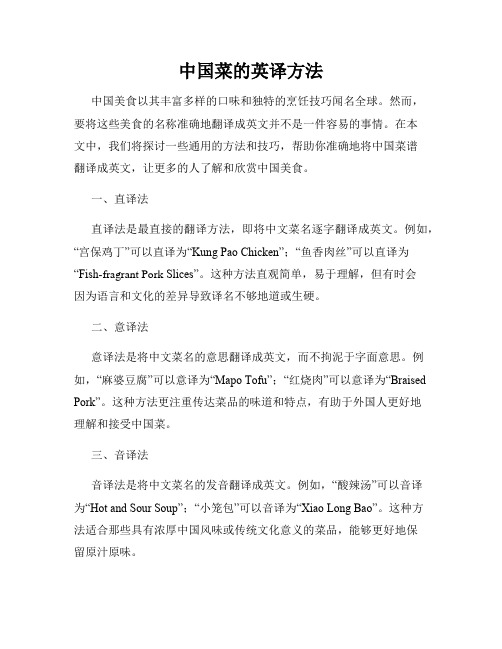
中国菜的英译方法中国美食以其丰富多样的口味和独特的烹饪技巧闻名全球。
然而,要将这些美食的名称准确地翻译成英文并不是一件容易的事情。
在本文中,我们将探讨一些通用的方法和技巧,帮助你准确地将中国菜谱翻译成英文,让更多的人了解和欣赏中国美食。
一、直译法直译法是最直接的翻译方法,即将中文菜名逐字翻译成英文。
例如,“宫保鸡丁”可以直译为“Kung Pao Chicken”;“鱼香肉丝”可以直译为“Fish-fragrant Pork Slices”。
这种方法直观简单,易于理解,但有时会因为语言和文化的差异导致译名不够地道或生硬。
二、意译法意译法是将中文菜名的意思翻译成英文,而不拘泥于字面意思。
例如,“麻婆豆腐”可以意译为“Mapo Tofu”;“红烧肉”可以意译为“Braised Pork”。
这种方法更注重传达菜品的味道和特点,有助于外国人更好地理解和接受中国菜。
三、音译法音译法是将中文菜名的发音翻译成英文。
例如,“酸辣汤”可以音译为“Hot and Sour Soup”;“小笼包”可以音译为“Xiao Long Bao”。
这种方法适合那些具有浓厚中国风味或传统文化意义的菜品,能够更好地保留原汁原味。
四、组合法组合法是将直译法、意译法和音译法相结合,根据不同菜品的特点和背景进行灵活运用。
例如,“糖醋排骨”可以组合为“Sweet and Sour Spareribs”;“冰糖炖雪梨”可以组合为“Snow Pear Stewed with Rock Sugar”。
这种方法能够在保留原味的基础上,更好地适应英文的表达习惯和口味需求。
通过以上几种方法的灵活运用,我们可以更准确地将中国菜名翻译成英文,让外国人更好地了解和品尝中国美食。
同时,也能够促进中外文化交流,增进各国人民之间的友谊和理解。
希望这些方法能够帮助大家更好地传播和推广中国美食,让世界各地的人们都能品尝到地道的中国味道。
目的论指导下的《舌尖上的中国》菜名英译策略

# 目的论指导下的《舌尖上的我国》菜名英译策略## 1. 引言在本文中,我将探讨目的论在《舌尖上的我国》菜名英译策略中的应用。
通过深度分析和广度排查,《舌尖上的我国》中的菜名英译策略不仅是对中华美食文化的传播,更是对我国饮食文化的体现。
从简到繁,由浅入深地探讨,可以帮助我们更好地理解菜名英译背后的文化内涵。
## 2. 目的论在菜名英译中的应用### 2.1 菜名英译的目的在菜名英译策略中,目的是至关重要的。
《舌尖上的我国》以展示我国饮食文化为主要目的,因此菜名的英译需以准确、生动、富有我国特色的方式呈现给外国观众。
### 2.2 文化内涵的传达在《舌尖上的我国》中,菜名的英译不仅仅是对食材和烹饪方法的翻译,更是对我国饮食文化的传达。
通过深入研究我国饮食文化的内涵,菜名的英译可以更好地体现出中华美食的独特魅力。
## 3. 菜名英译的具体策略### 3.1 直译与意译结合在菜名英译过程中,直译与意译的结合是非常重要的。
有些菜名可以直接翻译成英文,如“鱼香肉丝”,而有些菜名则需要进行意译,以表达其中的文化内涵,如“宫保鸡丁”。
### 3.2 应用汉字谐音汉字谐音在菜名英译中应用广泛,例如“佛跳墙”即为一种利用字谐音来表达菜品独特性的典型案例。
### 3.3 注重菜品特色在英译菜名时,需注重突出菜品的特色和特点。
比如“东坡肉”,其英译应该能够突出该菜品的历史内涵和烹饪方法。
## 4. 个人观点和理解在《舌尖上的我国》中,菜名英译是对我国饮食文化的推广和传承。
通过深度的研究和精准的翻译,这些菜名不仅成为了我国美食的形象代表,更成为了中华饮食文化的传播媒介。
## 5. 结语通过本文的探讨和分析,我们更深入地理解了《舌尖上的我国》菜名英译策略中目的论的应用。
在菜名英译过程中,深度和广度的考量是非常重要的,只有如此,才能更好地传达我国饮食文化的精髓。
以上就是我根据你提供的主题所撰写的文章,希望能够满足你的要求。
中国菜名翻译规则及范例

中餐菜名翻译的目标和基本原则
准确形象地把中式菜肴名称译为英语,让外国友人不仅能亲口品尝到我国菜肴 的独特风味,还能从菜名了解中式菜肴的烹调艺术和文化内涵,菜名的英译起 着重要的作用。我们的翻译能够达到的目标是:首先应该能让外国人看懂,让 外国客人了解菜的原料和烹调的主要方法,其次应反映出菜肴“色、香、味、 形”的主要特点,如有可能还应简略介绍与菜肴有关的民俗风情或历史传说, 即保持菜名所蕴含的文化特色,文字应该简洁明了。菜谱的翻译过程中如何
餐饮翻译原则
三. 以形状、口感为主、原料为辅的翻译原则 1.菜肴形状或口感以及主配料 形状/口感 + 主料 玉兔馒头 Rabbit-Shaped Mantou 脆皮鸡 Crispy Chicken
ຫໍສະໝຸດ 2.菜肴的做法、形状或口感、做法以及主配料 做法(动词过去分词)+ 形状/口感 + 主料 + 配料 红烧狮子头 Stewed minced pork balls with soy sauce
CUISINE TRANSLATION
Cuisine styles & Translation methods
中式菜肴名称的翻译方法
餐饮专业英语主要包括日常会话用语、烹饪技术用语和中餐英文菜单等等,而 这其中尤以中餐英文菜单用得最为普遍。有些菜名很形象化,我们不能从字面 上得知其主料与做法,所以对这样的菜名,就要查询这道菜的主料与做法,然 后再译,绝不能按字面翻译,否则就要闹笑话了。中国文化源远流长,中国美 食享誉世界,而菜谱有着丰富的文化内涵,文字底蕴非常丰富,有些菜名有特殊 的来历,涉及一些典故。比如“宫保鸡丁”、“水煮鱼”、“辣子鸡”等中国 老百姓喜欢的菜名。所以中餐菜名命名方式,既有现实主义的写实手法,即反 映菜肴内容和特色的写实性命名法。又有浪漫主义的写意笔调,既蕴含着丰富 的历史文化背景,又充满着民俗情趣和地方风味。即反映菜肴深刻含义的写意 性命名法。因此,有的菜名已不单纯是一个菜肴的名称,而是一个可引发丰富 联想的艺术品名,背后流传着动人的传说。具体来说,根据中餐菜名构成特点 可以将中餐菜名分成5类,英译方法则可以从读者心理期待入手,结合跨文化交 际特点,对不同类别的中餐菜名采取直译、音译、音译加释义、意译等不同的 翻译方法。
中国菜名翻译技巧
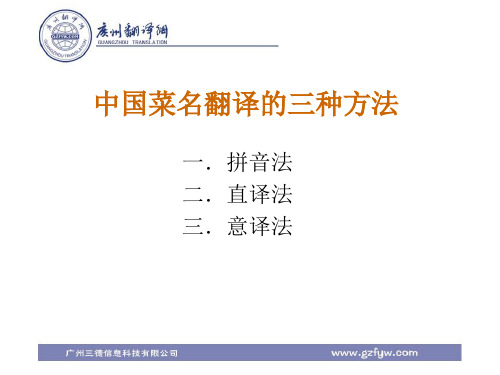
佛跳墙 Fotiaoqiang--Steamed Abalone with Shark’s Fin and Fish Maw in Broth (Lured by its delicious aroma even the Buddha jumped over the wall to eat this dish.) 窝头 Wotou(Steamed Black Rice or Corn Bun) 驴打滚儿 Lǘdagunr(Glutinous Rice Rolls with Sweet Bean Flour) 豆汁儿 Douzhir (Fermented Bean Drink)
直译法
英译时直接按中文菜名译出其意,在其后可 对其含义进行适当的补充。 例如: 狮子头 Lion’s Head ——Pork Meat Balls 全家福 Happy Family——A combination of shrimps, pork, beef, chicken, lobster and mixed vegetables with brown sauce
对于某些使用汉语拼音不能明白的菜名,可 在其后标注相应的英文注释 例: 蒸饺 Steamed Jiaozi (Steamed Dumplings) 油条 Youtiao (Deep-Fried Dough Sticks) 汤圆 Tangyuan (Glutinous RiceBalls 锅贴 Guotie (Pan-Fried Meat Dumplings 粽子 Zongzi (Glutinous Rice Wrapped in Bamboo Leaves) 元宵 Yuanxiao(Glutinous Rice Balls for Lantern Festival)
3.介绍菜肴的形状(口感)、主料和味汁 公式:形状(口感)+主料+(with)味汁 例:茄汁鱼片sliced fish with tomato sauce 椒麻鸡块cutlets chicken with hot pepper
如何翻译中国菜名
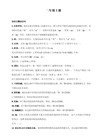
例:芝麻酥鸡crisp chicken with sesame
陈皮兔丁diced rabbit with orange peel
时蔬鸡片Sliced chicken with seasonal vegetables
2介绍菜肴的口感、烹法和主料
公式:口感+烹法+主料
1.sauteed chicken cubes with peanuts
2.Gongbao chicken cubes
3.diced chicken with chilli and peanuts
由此可见,中餐菜名的英译方法是习惯和具体情况确定。不过根据笔者的经验,只要掌握了第一种以主料开头的翻译方法,对其它种类的翻译方法便可以触类旁通,我们只需根据文中所列出的翻译公式去相应作一些交换就行了。
例:芥末鸭掌duck webs with mustard sauce
葱油鸡chicken in Scallion oil
米酒鱼卷fish rolls with rice wine
二、以烹制方法开头的翻译方法
1介绍菜肴的烹法和主料:
公式:烹法+主料(形状)
例:软炸里脊soft-fried pork fillet
2介绍菜肴的创始人(发源地)、烹法和主料
公式:人名(地名)+烹法+主料
例:东坡煨肘DongPo stewed pork joint
北京烤鸭Roast Beijing Duck
在中餐菜名翻译成英文的过程中,可以采用多种不同的方法,而且每一道菜都可以从不同的角度入手进行翻译。例如,川菜中的“宫保鸡丁”这道菜就有以下几种译法:
中国饮食文化中菜肴的英译原则与方法

中国饮食文化中菜肴的英译原则与方法摘要: 中国是一个饮食文化非常发达的国家,其菜肴名称丰富多彩,译者要了解每道菜的文化内涵,在翻译时才能精准地实现文化传播的目的。
本文浅析了中国菜肴的英译原则与具体翻译方法。
关键词: 中国饮食文化菜名英译原则具体方法一、中国菜名的英译原则1.对极具中国民族传统特色的菜,采用音译原则。
我国译者在翻译外国菜的过程当中,经常采用音译的方式。
比如,hamburger音译成“汉堡包”,sandwich音译成“三明治”。
这些音译的菜名保持了外国的饮食文化,有助于国人对外国的了解。
音译更能让外国友人了解中国菜的文化内涵,这对于加强中外文化交流是有利的。
就像我国已经接受了“麦当劳”和“肯德基”等西方快餐一样,中国的jiaozi,lo main,chow fan,tofu 等中国词汇已经被西方人接受。
因此在翻译此类名名称时,就可用音译,以保持原有风味特色和中国的文化特征。
西方国家一些中餐馆菜名音译以广东话发音基础,已成为约定俗成的用语,如炒粉(chow fun)、炒饭(chow fan)等,为西方人所接受。
为便于西方人理解,译者在翻译时最好沿用这些用法。
例如:牛肉炒粉(chow fun of beef)、扬州炒饭(Y angzhou chow fan)等。
2.音译加释义原则。
中国地域广阔人口众多,在长期的历史发展过程中,生活在不同的地域的人们逐渐形成具有本地域特征的饮食文化、烹调方法和菜肴口味,翻译这类展示地名类型的菜名时,译者可采用音译地名加上释义口味的方法进行翻译,这样可以让外国人更好地了解中国不同地域的饮食文化。
例如:湖南牛肉(Hunan Beef)thin slices of beef sautéed with black mixed vegetables in chef’s spicy hot pepper sauce 苏州熏鱼(Deep-fried Salmon,Suzhou Style)marinated salmon slices in the sauce of scallion,ginger,sugar after being deep-fried3.对菜名中包含原料的,采用直译原则。
中国菜英文翻译方法

中国菜英文翻译方法第一步:理解菜名意义首先,了解每道菜的中文名称的意义和背景。
这有助于你理解菜品的独特性和特点,以便更好地传达给读者。
了解每道菜的历史、起源和与中国文化相关的背景信息也是很有帮助的。
第二步:词语选择选择适当的英文词汇来翻译每道菜的名称是非常重要的。
在选择词语时,要根据菜品的特点和独特性遵循以下原则:1. 直译:有些菜名可以通过直译来传达它们的意义,这就是将中文菜名翻译成与其意义相对应的英文词语。
例如,“宫保鸡丁”可以直译为“Kung Pao Chicken”。
2. 描述特征:对于那些不容易直接翻译的菜名,可以选择描述它们的特征和组成部分的词语。
例如,将“回锅肉”翻译为“Twice-cooked Pork”。
3. 肉品地区:对于特定地区所产的肉类或特殊品种的肉类,可以使用该地区的名称加上英文名称来翻译。
例如,将“四川火锅”中的“四川”翻译为“Sichuan”,以表示该菜品来自四川地区。
4. 以食材命名:一些菜名是根据菜品的主要食材来命名的,可以选择直接将食材的名字翻译成英文,或者采用以该食材为特色的英文翻译。
例如,“红烧鱼”可以翻译为“Braised Fish”。
5. 依据菜品用途:有些菜名是根据菜品的用途或制作方法来命名的,可以选择具有相同用途或制作方法的英文词汇来翻译。
例如,“麻婆豆腐”可以翻译为“Mapo Tofu”。
第三步:使用逗号和连接词在翻译菜名时,可以使用逗号或者连接词来分隔不同的成分或描述菜品的特点。
这有助于读者更好地理解菜品的组成和特点。
例如,“苦瓜炒蛋”可以翻译为“Stir-fried Bitter Melon with Egg”。
第四步:注释和解释对于较为复杂或难以理解的菜名,可以在翻译后添加注释或解释来帮助读者理解其意义和特点。
这些解释可以提供菜品的来历、食材的特点和独特的制作方式,进一步加深读者对菜品的理解。
总结起来,中国菜英文翻译方法需要深入理解菜名的意义和特点,并选择合适的英文词汇进行翻译。
从中式菜名的英译看异化与归化策略的运用

从中式菜名的英译看异化与归化策略的运用
中式菜名的英译中,通常可看到异化与归化策略的运用。
异化策略是指直接将汉字音译成英文,使得英文读者难以理解该菜品的含义。
例如,“麻婆豆腐”直接翻译成“Mapo Tofu”,“宫保鸡丁”直接翻译成“Kung Pao Chicken”等。
这种翻译策略虽然符合英语拼写规则,但对于不了解中式菜品名称的外国人来说,仍然可能会感到陌生和困惑。
相反,归化策略是指将汉字直接翻译成英文,同时根据菜品的具体特点,采用更易理解的英文名称。
例如,“小笼包”就被翻译成“Steamed Soup Dumpling”,“红烧肉”被翻译成“Braised Pork Belly”等。
归化策略的翻译通常更具备英语语言习惯和菜品特质的融合,更易于外国读者理解和接受。
因此,在翻译中式菜名时,既要考虑到英语语言的规范性,又要注意到目标受众的语言习惯和文化背景。
在不同的场合下,可采用不同的翻译策略,以达到更好的传播效果。
中餐菜名采用音译+释译的例子

中餐菜名采用音译+释译的例子
1. 宫保鸡丁 (Gong Bao Ji Ding) Kung Pao Chicken.
宫保鸡丁是一道四川菜,它的英文名称Kung Pao Chicken 就是采用了音译+释译的方式,将“宫保”音译为Kung Pao,而“鸡丁”则直接释译为Chicken。
2. 麻婆豆腐 (Ma Po Dou Fu) Mapo Tofu.
麻婆豆腐是一道以豆腐和肉末为主要食材的川菜,其英文名称Mapo Tofu同样采用了音译+释译的方式,将“麻婆”音译为Ma Po,而“豆腐”则释译为Tofu。
3. 糖醋里脊 (Tang Cu Li Ji) Sweet and Sour Pork.
糖醋里脊是一道常见的中式烹饪菜肴,其英文名称Sweet and Sour Pork同样是采用了音译+释译的方式,将“糖醋”音译为Sweet and Sour,而“里脊”则释译为Pork。
4. 锅贴 (Guo Tie) Potstickers.
锅贴是一种流行的中国小吃,其英文名称Potstickers同样采用了音译+释译的方式,将“锅贴”音译为Guo Tie,而“贴”则释译为Potstickers。
以上这些例子都展示了中餐菜名采用音译+释译的方式,这种翻译方式可以帮助外国人更好地理解和品尝中国美食,也是中餐国际传播的一种方式。
中国菜名翻译规则
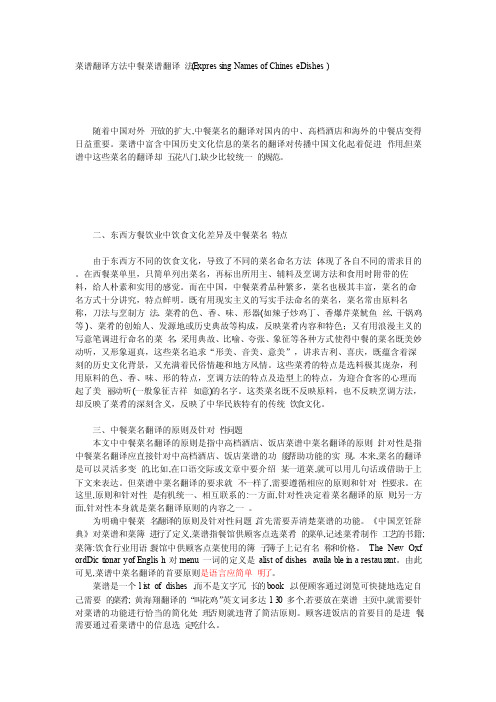
菜谱翻译方法中餐菜谱翻译法(Expressi ng Names of Chinese Dishes)随着中国对外开放的扩大,中餐菜名的翻译对国内的中、高档酒店和海外的中餐店变得日益重要。
菜谱中富含中国历史文化信息的菜名的翻译对传播中国文化起着促进作用,但菜谱中这些菜名的翻译却五花八门,缺少比较统一的规范。
二、东西方餐饮业中饮食文化差异及中餐菜名特点体现了各自不同的需求目的由于东西方不同的饮食文化,导致了不同的菜名命名方法,<。
在西餐菜单里,只简单列出菜名,再标出所用主、辅料及烹调方法和食用时附带的佐料,给人朴素和实用的感觉。
而在中国,中餐菜肴品种繁多,菜名也极其丰富,菜名的命名方式十分讲究,特点鲜明。
既有用现实主义的写实手法命名的菜名,菜名常由原料名称,刀法与烹制方法、菜肴的色、香、味、形器(如辣子炒鸡丁、香爆芹菜鱿鱼丝、干锅鸡等)、菜肴的创始人、发源地或历史典故等构成,反映菜肴内容和特色;又有用浪漫主义的写意笔调进行命名的菜名,采用典故、比喻、夸张、象征等各种方式使得中餐的菜名既美妙动听,又形象逼真,这些菜名追求“形美、音美、意美”,讲求吉利、喜庆,既蕴含着深刻的历史文化背景,又充满着民俗情趣和地方风情。
这些菜肴的特点是选料极其庞杂,利用原料的色、香、味、形的特点,烹调方法的特点及造型上的特点,为迎合食客的心理而起了美丽动听(一般象征吉祥如意)的名字。
这类菜名既不反映原料,也不反映烹调方法,却反映了菜肴的深刻含义,反映了中华民族特有的传统饮食文化。
三、中餐菜名翻译的原则及针对性问题本文中中餐菜名翻译的原则是指中高档酒店、饭店菜谱中菜名翻译的原则,针对性是指中餐菜名翻译应直接针对中高档酒店、饭店菜谱的功能,帮助功能的实现。
本来,菜名的翻译是可以灵活多变的,比如,在口语交际或文章中要介绍某一道菜,就可以用几句话或借助于上下文来表达。
中餐菜名的英译方法
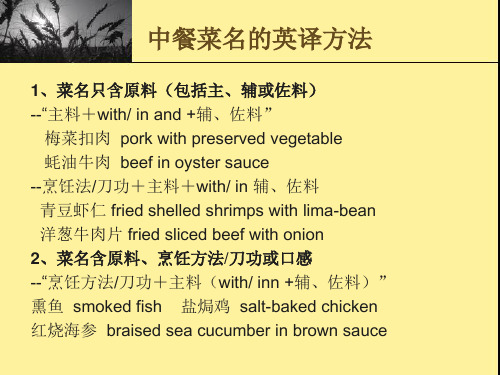
中餐菜名的英译方法
--“口感+主料(+with/ in+ 辅、佐料)” 香酥排骨 crisp fried spare ribs 黄酒脆皮虾 crisp shrimps with rice wine sauce 3、菜名含原料、烹饪方法及菜肴发源地 --烹饪方法+菜肴发源地+原料 北京烤鸭 Beijing roast duck/ roast Beijing duck 园林液香鸡 boiled chicken with spicy sauce --烹饪方法+原料+菜肴发源地+style 扬州炒饭 fried rice, Yangzhou style 潮州烧鹅 roast goose, Chaozhou sty名字 这类菜名有的直接将人名译出,有的则认为应该译出原 料和烹饪方法 麻婆豆腐 Mapo tofu/ Mapo bean curd/ sauted spicy tofu, Sichuan style 东坡肉 Dongpo pork/ sweet-sour pork fillet with chilli 音译法:常用于中国特色食品的翻译 ho fun, mei fun, wanton, dim sum, shiu mai, you tiu
中餐菜名的英译方法
1、菜名只含原料(包括主、辅或佐料) --“主料+with/ in and +辅、佐料” 梅菜扣肉 pork with preserved vegetable 蚝油牛肉 beef in oyster sauce --烹饪法/刀功+主料+with/ in 辅、佐料 青豆虾仁 fried shelled shrimps with lima-bean 洋葱牛肉片 fried sliced beef with onion 2、菜名含原料、烹饪方法/刀功或口感 --“烹饪方法/刀功+主料(with/ inn +辅、佐料)” 熏鱼 smoked fish 盐焗鸡 salt-baked chicken 红烧海参 braised sea cucumber in brown sauce
中文菜名英文译法原则

中文菜名翻译的原则一、以主料开头的翻译原则1、介绍菜肴的主料和配料:主料(名称/形状)+ with + 配料。
如:白灵菇扣鸭掌Mushrooms with Duck Feet2.介绍菜肴的主料和配汁:主料+ with/in + 汤汁(Sauce)。
如:西湖醋鱼West Lake Fish in Vinegar Sauce, 龙井虾仁Fried Shrimps with Longjing Tea,片儿川Noodles with Preserved Vegetable & Sliced Pork & Bamboo Shoots in Soup介词in和with在汤汁、配料中的用法1、如主料是浸在汤汁或配料中时,使用in连接。
如:豉汁牛仔骨Steamed Beef Ribs in Black Bean Sauce,2、如汤汁或蘸料和主料是分开的,或是后浇在主菜上的,则用with连接。
如:海鲜乌冬汤面Japanese Soup Noodles with Seafood二、以烹制方法开头的翻译原则1、介绍菜肴的做法和主料:做法(动词过去式)+主料(名称/形状)。
如:火爆腰花Sautéed Pig's Kidney2、介绍菜肴的做法、主料和配料:做法(动词过去式)+主料(名称/形状)+ 配料。
如:地瓜烧肉Stewed Diced Pork and Sweet Potatoes / 干豆角回锅肉Sautéed Spicy Pork with Dried Beans3、介绍菜肴的做法、主料和汤汁:做法(动词过去式)+主料(名称/形状)+ with/in +汤汁。
如:京酱肉丝Sautéed Shredded Pork in Sweet Bean Sauce / 雪蛤海皇羹Snow Clam and Scallop Soup炒/暴炒/炸/煎/清炒:sautéing/quick-frying/deep-frying/frying/plain-frying清蒸/烘焙/红烧:Steaming/roasting, broiling/braising with soy sauce煲;焖/烫:braising; stewing; simmering /scalding 麻辣烫:searing hot-pot三、以形状或口感开头的翻译原则1、介绍菜肴形状或口感以及主配料:形状/口感+ 主料。
中餐菜名翻译概述

一、以主料开头的翻译方法例:杏仁鸡丁Chicken Cubes with Almond西红柿炒蛋Scrambled Egg with Tomato芥末鸭掌Duck Webs with Mustard Sauce米酒鱼卷Fish Rolls with Rice Wine二、以烹制方法开头的翻译方法例:软炸里脊Soft-fried Pork Fillet烤乳猪Roast Suckling Pig仔姜烧鸡条Braised Chicken Fillet with Tender Ginger红烧牛肉Braised Beef with Brown Sauce鱼香肉丝Fried Shredded Pork with Sweet and Sour Sauce 清炖猪蹄Stewed Pig Hoof in Clean Soup三、以形状或口感开头的翻译方法例:芝麻酥鸡Crisp Chicken with Sesame陈皮兔丁Diced Rabbit with Orange Peel香酥排骨Crisp Fried Spareribs水煮嫩鱼Tender Stewed Fish茄汁鱼片Sliced Fish with Tomato Sauce黄酒脆皮虾仁Crisp Shrimps with Rice Wine Sauce四、以人名或地名开头的翻译方法例:麻婆豆腐Ma Po Bean Curd四川水饺Sichuan Boiled Dumpling北京烤鸭Beijing Roast Duck一些主要词组:味道(Flavor):酸辣Hot and Sour白灼Scald糖醋Sweet-and-Sour鱼香Fish-flavored椒盐 Pepper and Salt麻辣Spicy and Hot什锦Mixed五香Spiced做法(Cookery):清蒸Steam炒 stir-fry,Sauté(Meat/Vegetable),Scramble(Eggs)红烧 Braise with Soy Sauce/In Brown Sauce煲 Cook with Chinese Pot水煮 Poached炖Stew熏Smoke烤 Roast腌Salting/Pickling锅贴 Pan-Fried滑溜Sauté…with Sauce拔丝Toffee酱爆Sauté… with Soya Paste烧Grill/Broil Meat炸Deep-fry形状(Shape):丁Dice片Slice丝Shred末Mince以下是常用菜名1, 冷菜类Cold Dishes:什锦冷盘Assorted Cold Dishes三色冷盘Three Kinds of Cold Dish酸辣黄瓜Hot and Sour Cucumber咸水鸭Salted Duck辣白菜Spicy Cabbage2, 蔬菜类Vegetables:红烧豆腐Fried Tofu西红柿炒蛋Scrambled egg with tomato红烧二冬Braised Chinese Mushroom and Bamboo Shoots 蚝油生菜Lettuce with Oyster Sauce蚝油冬菇Chinese Mushrooms with Oyster Sauce酸辣菜花Sweet and Sour Cauliflower炸茄盒Fried Eggplant with Meat Stuffing豪油冬菇Oyster Sauce Mushroom什笙上素Bamboo Vegetable炒素丁Vegetable Roll罗汉腐皮卷Vegetable Egg Roll素咕噜肉Vegetarian Sweet and Sour pork蒸山水豆腐Steam Tofu鲜菇扒菜胆Mushroom Tender Green炒杂菜Mixed Green Tender清炒芥兰Chinese Green Tender盐水菜心Salt Green Tender干扁四季豆String Bean Western Style上汤芥菜胆Mustard Green Tender3, 汤羹类Soup:肉丝榨菜汤Shredded Pork with Chinese Pickles 酸辣汤Hot and Sour Soup丸子汤Meat Ball Soup鸡丝豆花汤Chicken and Bean Curd Soup鱼丸汤Fish Ball Soup贡丸汤Meat Ball Soup蛋花汤Egg & Vegetable Soup蛤蜊汤Clam Soup牡蛎汤Oyster Soup紫菜汤Seaweed Soup馄饨汤Wonton Soup猪肠汤Pork Intestine Soup肉羹汤Pork Thick Soup鱿鱼汤Squid Soup粟米瑶柱羹Corn with Dry Scallops Soup竹笙海皇羹Bamboo Seafood Soup鸡蓉粟米羹Corn & Chicken Soup杂锦云吞汤Combination Won Ton Soup芥菜肉片咸蛋汤Mustard Green Salted Egg Soup火鸭咸蛋芥菜汤Roast Duck Salt Egg / Mustard Green 四宝豆腐羹Steam Tofu Soup4,海鲜鱼类Fish and Seafood:糖醋全鱼Fried Whole Fish with Sweet and Sour Sauce 软炸虾仁Fried Prawns清蒸全鱼Whole Steamed Fish青豆虾仁Shrimps with Green Beans菜远虾球Shrimp with Tender Green白灼中虾Boil Shrimp点桃虾球Walnut Shrimp油泡虾球Crystal Prawn柠檬虾球Lemon Prawn虾龙糊Shrimp w/ Lobster Sauce马拉盏炒鲜鱿Special Fresh Squid碧绿炒带子Tender Green Scallop双菇鲜带子Mushroom Fresh Scallop清蒸游水石斑Steam Live Rock Cod辣汁串烧鱼B & Q Fish Stick w/ Hot Sauce西兰炒雪鱼球Pan Fried Snow Fish w/ Green菜远石斑球Tender Green Rock Cod油泡石斑球Crystal Rock Cod川味石斑球Szechwan Rock Cod骨香石斑球Fried Rock Cod Bon咕噜石斑球Sweet & Sour Rock Cod鱼腐扒菜胆Yu Fu w/ Vegetable5.鸡鸭类Chicken and Duck:宫爆鸡丁Spicy Chicken with Peanuts腰果鸡Chicken with Cashew Nuts北京烤鸭Peking Roast Duck杏仁鸡丁Diced Chicken with Almonds葱油鸡chicken in Scallion oil香妃鸡Steamed chicken with salted sauce 糖醋鸡块Chicken in sweet and sour sauce脆皮炸子鸡(半)Fried Chicken (Half)姜葱油淋鸡(半)Green Onion Chicken (Half)北京片皮鸭Peking Duck酸甜明炉烧鸭(半)Roast Duck (Half)柠檬鸡球Lemon Chicken西芹腰果鸡球Vegetable Cashew Chicken咖喱鸡Curry Chicken四川炒鸡球Szechwan Chicken菜远鸡球Chicken w/ Tender Green咕噜鸡Sweet & Sour Chicken八珍发菜扒鸭(半)Combination Duck (Half)子罗炒鸡片Ginger & Pineapple Chicken游龙戏凤Chicken, Shrimp, Squid w/ Mixed Vegetable龙凤琵琶豆腐Egg, Chicken, Shrimp, Steam Tofu6.猪牛肉类Pork and Beef:鱼香肉丝Fish-flavored Pork回锅肉Twice Cooked Pork咕老肉Sweet and Sour Pork青椒肉丝Shredded Pork with Green Pepper糖醋排骨Sweet and Sour Spare Ribs鱼香牛肉丝Fish-flavored Beef红烧土豆牛肉Braised Beef and Potato洋葱牛肉丝Shredded Beef with Onion酸甜咕噜肉Sweet & Sour Pork菜远炒排骨Spareribs w/ Tender Green京都骨Peking Spareribs椒盐排骨Pepper Salt Spareribs菜远炒牛肉Broccoli Beef凉瓜炒牛肉Bitty Melon Beef黑椒牛仔骨Black Pepper Short Rib椒盐牛仔骨Pepper Salt Short Rib中式牛柳Chinese Style Beef干扁牛柳丝String Beef柠檬牛肉Lemon Beef麻婆豆腐Mar-Po Tofu7.点心dessert :糖葫芦Tomatoes on Sticks长寿桃Longevity Peaches芝麻球Glutinous Rice Sesame Balls麻花Hemp Flowers双胞胎Horse Hooves臭豆腐Stinky Tofu (Smelly Tofu)油豆腐Oily Bean Curd虾片Prawn Cracker虾球Shrimp Balls春卷Spring Rolls蛋卷Chicken rolls碗糕Salty Rice Pudding筒仔米糕Rice Tube Pudding红豆糕Red Bean Cake绿豆糕Bean Paste Cake糯米糕Glutinous Rice Cakes萝卜糕Fried White Radish Patty芋头糕Taro Cake雪哈红莲Bird Nest Red Bean Soup椰汁炖雪哈Coconut Bird Nest玫瑰红豆沙Red Bean Soup椰汁西米露Coconut Tapioca百年好合Red Bean Fresh Lily Bulb8.其它一些常用饭菜名:豆浆Soybean Milk板条Flat Noodles烧饼Clay Oven Rolls榨菜肉丝面 Pork , Pickled Mustard Green Noodles 油条Fried Bread Stick米粉Rice Noodles水饺(Boiled)Dumplings紫菜汤 Seaweed Soup馒头 Steamed Buns, Steamed Bread牡蛎汤Oyster Soup饭团Rice and Vegetable Roll蛋花汤Egg & Vegetable Soup皮蛋preserved Egg鱼丸Fish Ball咸鸭蛋Salted Duck Egg臭豆腐Stinky Tofu (Smelly Tofu) 稀饭Rice Porridge油豆腐Oily Bean Curd白饭Plain White Rice虾球Shrimp Balls糯米饭 Glutinous Rice春卷Spring Rolls蛋炒饭Fried Rice with Egg蛋卷Chicken Rolls刀削面 Sliced Noodles肉丸 Rice-meat Dumplings麻酱面Sesame Paste Noodles鸭肉面Duck With Noodles鳝面Eel Noodles麻辣面Spicy Hot Noodles火锅Hot Pot乌龙面Seafood Noodles卤味Braised Food。
- 1、下载文档前请自行甄别文档内容的完整性,平台不提供额外的编辑、内容补充、找答案等附加服务。
- 2、"仅部分预览"的文档,不可在线预览部分如存在完整性等问题,可反馈申请退款(可完整预览的文档不适用该条件!)。
- 3、如文档侵犯您的权益,请联系客服反馈,我们会尽快为您处理(人工客服工作时间:9:00-18:30)。
中国菜名的翻译策略STRATEGIES FOR THE TRANSLATION OFCHINESE DISH NAME摘要在中国,烹饪是一门古老的艺术。
早在3000多年前,中国人就已经知道如何美味调配酸、甜、苦、辣、咸这五味。
在清朝年间,一些海外华人在英国和其他国家开设了中国餐馆,从那时起中国菜开始名扬世界,中国餐馆也遍布世界许多国家和地区。
中国菜做工精细,品种多样,被世界不同民族的人们所喜爱。
随着世界全球化的不断发展,中国菜会成为越来越多的国际友人了解中国的一个重要窗口。
中国菜名本是汉语自身的问题,其文化含义也非常清楚,但是当我们将中国菜名译成英文,介绍给外国人时,就出现了语际问题。
相应地,中国菜名的文化含义也就变成了一个跨文化问题,因为翻译是一个跨文化和跨语言的问题,我们必须考虑到两种语言和两种文化的差异。
本篇论文从理论和实践两个角度分析了翻译策略,指出如何正确的翻译中国菜名,并详细讨论了一些特殊菜名。
归纳总结翻译中餐菜名的通用方法:直译法,直译加注法,意译法,同时强调了文化在翻译和交流中的重要作用。
关键词:奈达的翻译理论;中国菜名的翻译;翻译策略;跨文化交际1 IntroductionChinese dishes are known for their variety and abundance. The dishes can be classified into four major cuisines, namely, Northern Cuisine, Sichuan Cuisine, Jiangzhe Cuisine and Southern Cuisine.With more and more contact with the world, Chinese food has become one of cultures symbolizing our country. As one part of our country’s culture, it has a long history and rich culture essences. When foreigners taste our delicious food, they also want to know the name essence of the dish, the raw material, and the cooking ways. Therefore, the translation of Chinese dish names plays a very important role in introducing dishes and spreading our diet culture. A well-translated dish name will help attract customers and inspire their desire for taste; while a dish name translated improperly sometimes will bring negative effect or ever lead to spoilage of the image of the dish.In following paper, we will discuss specific strategies for the translation of Chinese dish names from theoretical and practical perspectives. There are mainly three approaches in translating Chinese dish names: literal translation, literal translation with notes, and liberal translation.2 The Theory Applied to Translation of Chinese Dish Names2.1 Eugene NidaEugene A .Nida, a famous American translator of the Bible, is well known for his works in semantic structure and translation theory. Nida’s theory of translation developed from his own practical work in the 1940s onwards when he was translating and organizing the translation of the Bible. His theory generally contains two concepts: Formal Equivalence and Dynamic Equivalence.2.2 Eugene Nida’s theory of translation2.2.1 Formal equivalence translationFormal Equivalence is defined by Nida as one of “two different types of equivalence”,which “focuses attention on the message itself, in both form and content”. Formal equivalence is thus the “quality of a translation in which the features of the form of source text have been mechanically reproduced in the receptor language” (Nida&Taber, 1969\1982: 201). The aim of a translator who is striving for formal equivalence is to allow ST to speak “in its own terms” rather than to attempt to adjust it to the circumstances of the target culture; in practice this means, for example, using “Formal Equivalents” rather than “Functional Equivalents” wherever possible, not joining or splitting sentences, and preserving formal indicators such as punctuation marks and paragraphs breaks (Nida, 1964: 165). The frequent result ofsuch strategies is of course that, because of differences in structure between SL and TL, a translation of this type “distorts the grammatical and stylistic patterns of the receptor language, and hence distorts the message” (Nida&Taber, 1969\1982:201). For this reason, it is frequently necessary to include explanatory notes to help the target reader (Nida, 1964:166). So a general tendency towards formal than dynamic equivalence is characterized by, for example, a concern for accuracy and a preference for retaining the original wording wherever possible. In spite of its apparent limitations, however, formal equivalence is sometimes the most appropriate strategy to follow: besides frequently being chosen for translating biblical and other sacred texts, it is also useful for Back-Translation and for when the translator may for some reason be unwilling to accept responsibility for changing the wording of TT (Hatim&Hason, 1990:7).2.2.2 Dynamic Equivalence TranslationDynamic Equivalence is based on what Nida called “the principle ofequi valent effect” where “the relationship between receptor and message should be substantially the same as that which existed between the original receptors and the message” (1964:159). The message has to be modified to the receptor’s linguistic needs and cul tural expectation and “aims at complete naturalness of expression”. He defines the goal of dynamic equivalence as seeking “the closest natural equivalent to the SL message” (1969:12).In other words, a dynamically equivalent translation is one which has been produced in accordance with the three fold process of Analysis, Transfer 2, and Restructuring (Nida&Taber, 1969\1982:200); formulating such a translation sill entail such procedures as substituting TL items which are more culturally appropriate for obscure ST items, making linguistically implicit ST information explicit, and building in a certain amount of Redundancy to aid compression. In a translation of this kind one is therefore not so concerned with “matching the receptor language message with the s ource language message”; the aim is more to “relate the receptor to modes of behavior relevant within the context of his own culture” (Nida,1964:159).Nida&Taber argue that a “high degree” of equivalence of response is needed for the translation to achieve its purpose, although they point out that this response can never been identical with elicited by the original (Nida&Taber,1969\1982:24).2.3 Comments on the TheoryNida played an important role in pointing the road away from strict word-for-word equivalence. His introduction to the concepts of formal and dynamic equivalence is crucial in introducing a receptor-based (or reader-based) orientation to translation theory. However, both the principle of equivalent effect and the concept of equivalence have come to be heavily criticized for a number of reasons. Lefevere (1993:78) consider equivalent or response to be impossible. One of Nida’s fiercest critics is Edwin Gentzler, who denigrates Nida’s work for its theological andproselytizing stand point with the concept that dynamic equivalence serves the purpose of converting the receptors, no matter what their culture, to the dominant discourse and ideas of Protestant Christianity. However, Nida has “achieved what few of his predecessors attempted” and his in fluence in translation studies spans five decades and has left an indelible mark in the field of translation (Munday, 2001:43).3 Cross- cultural Communication3.1 Relationship between Culture and translationWhen learning a language, a saying is “learni ng a language is a kind of learning the culture and habit of the country where the language is spoken”. In translation, we may say that translating a source language text is a kind of translating the source language culture and habit of the country where the source language is spoken.3.1.1 The Definition of CultureWhat does the word” culture” mean? It may mean many things. For example, we sometimes say that people who are able to read and write or who know about art, music and literature are cultured. For different people, the word has a different meaning.In fact, culture is really a large and evasive concept, very complex and difficult to define. It is said that there have been at least over 150 definitions of culture, but none of them seems to be able to tell us everything about culture. The following definitions are just some of the well-known ones.“Culture may be defined as what a society does and thinks” (Sapir, 1921).“What really binds men together is their culture—the ideas and the standards they have in common”(R. Benedict, 1935).“Culture is man’s medium; there is not one aspect of human life that is not touched and altered by culture. This means personality, how people express themselves, including shows of emotion, the way they think, how they move, how problems are solved, how their cities are planned and laid out, how transportation systems function and are organized, as well as how economic and government systems are put together and function”.(Edward T. Hall, 1959)3.1.2 The Definition of TranslationTranslation is also an incredibly broad notion which can be understood in many different ways.As Jakobson defines translation as “an interpretation of verbal signs by means of some other language” (1959\1966:233). An approach based on the importance ofpreserving the effect of the original is reflected in Nida&taber’s definition: “translation consists in reproducing in the receptor language the closest national equivalent of the source-language message, first in terms of meaning and secondly in terms of style”(Nida&taber,1982:12). Vermeer, rejecting notions of translation as a two-stage process of decoding and recording, offers a similarly non-normative definition of translation as “information about a source text in another language” (1982:97). This approach engenders a view of translation in which the way a TT functions in a specific cultural context is paramount: “translation is the production of a functional target text that is specified according to the intended or demanded function of the target text(translation skopos)”(Nord,1991:28 ).3.1.3 Relationship between Culture and TranslationHere we will introduce another term “cross-cultural translation”. This term refers to types of translation which function as a tool for cross-cultural or anthropological research, or indeed to any translation which is sensitive to cultural as well as linguistic factors.Most translators recognize that each language contains elements which are derived from its culture, that every text is anchored in a specific culture, and that conventions of text production and reception vary from culture to culture (Koller, 1979\1992:59-60). An awareness of such issues can at times make it more appropriateto think of translation as a process which occurs between languages. Skopos Theory, Thick Translation and Translational Action are all examples of this type of approach.In other words, a cross-cultural translation is one in which additions are made which cannot be directly derived from the original ST wording; these might take the form of ideas culturally foreign to ST, or even elements which are simply included to provide necessary background information.3.2 Cultural Connotation Embodied in Chinese Dish NamesIn the following, we’l l discuss the translation of Chinese dish names. Eating is also a culture. All individuals must eat in order to survive—but what people eat, when they eat, and the manners in which they eat are all patterned by culture.Chinese dishes are known for their variety and abundance. As one part of our country’s culture, Chinese dish has a long history and rich culture essences. Many cultural connotations are embodied in Chinese dish names. Some interesting stories or legendary stories are contained in the background of a dish name. Furthermore, some special dish names have become a symbol of city or our country.Take “Beijing roast duck” for example. It is a carefully prepared dish. Selected ducks are fed at regular intervals so that they will gain more flesh. The ducksare roasted slowly so that the skin becomes crispy and brown, and the flesh juicy and tender. To eat them, the meat is carefully cut into bite-sized pieces and accompanied by a special Chinese sauce with spring onion, which is then rolled in paper-thin pan cakes before eaten. This dish has become a symbol food of Beijing or even our country. Most foreigners all taste it when they come to <st1:country-regionw:st="on">China, when foreigners hear “Beijing roast duck”, they can easily associate it with Beijing.Take “Beggar’s Chicken” for another example. We called this dish “Beggar’s Chicken” for there is an interesting story. A beggar stole a chicken and kindled a fire by a river bank to eat it. Before it was finished cooking, he heard his pursuers. He doused the fire and buried the chicken in the ground, hoping to come back to it later. He did, dug it up, and found it to be quite succulent. So “Beggar’s Chicken” is added to the list of Chinese dishes. ( 陈小慰,2006:221)In order to deliver more information to readers, translators often add some background information to Chinese dish names, it also sounds interesting for foreigners.4 Strategies for the Translation of Chinese Dish NameTranslation is an art, a bilingual art, which is considered as the cultural bridge and media between two languages. As there exist wide differences in vocabulary andculture between <st1:country-region w:st="on">China and Western countries, translation is no easy job, especially the translation of some traditional Chinese dish names. Therefore, in order to keep the flavor of the original Chinese dish and the beauty of language as well as cater for all the foreigners, translation skills should be reasonably employed in the process of translating, such as the following three.4.1 Literal TranslationLiteral translation can be defined in linguistics as translation “made on a level lower than is sufficient to convey the content unchanged while observing TL norms”. (Bark hudarov, 1969:10 ). In a similar vein Catford also offers a definition based on the notion of the UNIT OF TRANSLATION: he argues that literal translation takes world-for-world translation as its starting point, although because of the necessity of confirming to TL grammar, the final TT may also display group-group orclause-clause equivalence. (1965:25)In translating Chinese dish names, by literal translation, the translator can keep the original form of Chinese dish names without causing confusion in meaning. What’s more, it introduces the raw material to foreigners and avoids some troubles between two different diets. The most important point lies in the function of keeping the full flavor of Chinese Dish.We will discuss this translation according to three different structures:(a)cooking method +raw material烧鹅roast goose涮羊肉instant boiled mutton脆皮锅酥肉deep fried pork(b)cooking method +raw material +with +ingredients酿豆腐bean curd stuffed with minced pork糖醋排骨spareribs with sweet and sour sauce干烧明虾fried prawns with pepper sauce(c)cooking method +raw material +and + raw material虾仁扒豆腐stewed shelled shrimps and bean curd凤肝虾仁fried shelled shrimps and chicken liver红烧什肉虾仁豆腐fried bean curd, shelled shrimps and missed meat withbrown sauceThe feature of these Chinese dish names is actually describing materials, cooking methods and features of dishes.The notion of literal translation has been formalized by Nida as formal equivalence. It was defined by Nida as one of “two different types of equivalence”, which “focuses attention on the message itself, in both form and content” (1964:159). Readers can understand easily when they see the dish names, because this translation embodies the original information of the dishes.4.2 Literal Translation with NotesGood literal translation can help foreigners to acquire the direct information of Chinese dish, including raw material, flavor, and so on. But sometimes literal translation without any notes will puzzle readers so that trouble will be naturally produced. As Nida said, “ Since no two languages are identical, either in the meanings given to corresponding symbols or in which such symbols are arranged in phrases and sentences, it stands to reason that there can be no absolute correspondence between languages . Hence there can be no fully exact translation” (1966:156). So this kind of translating skill, literal translation with notes, may supply notes to Chinese dish names, for example, raw material, sources, background, special meaning, etc, thus may strengthen the comprehension of Chinese dish for foreigners, and deliver a more exact information of the dish and Chinese diet culture.Let’s see the following examples:(1)龙虎斗The dragon fighting with the tiger—Stewed snake and wild cat [注:在广东,“龙虎斗”是一道用蛇肉烧猫肉的名菜](2)佛跳墙Buddha-Jumps-Over-the Wall (This is Fujian’s Number1 special dish, carefully prepared with Shark’s fin, abalone and more than 20 other ingredients. This delicious dish is so tempting that even a Buddha will give up his sutra and jump over the wall for a taste of this irresistible dish).( 陈小慰,2006:219)(3)狮子头Lion’s head—pork meat balls(4)全家福Happy family—A combination of shrimps, pork, beef, chicken, lobster and mixed vegetables with brown sauce.(5)龙凤配Dragon&Phoenix—Two separate dishes characterize this distinctive plate. On one side, lobster meat in Sichuan chili sauce, which is inviting. On the other is house special chicken, which never fails in delighting.(6)左宗鸡General Tso’s chicken—A mouth watering dish made with large chunks of marinated chicken, sauteed with scorched red chili peepers in special, tangy sauce. (顾维勇,2005:94)(7)太平燕Fuzhou-style wonton and duck egg soup—The wrapper of the wonton is made of meat and sweet potato starch instead of flour and the dish is most often served on joyous occasions such as weddings and New Year’s Eve which is supposed to bring peace and good luck.Example (1) adopts “literal translation with notes”. Obviously, it is better than “literal translation” in this case. We can easily understand the dish—its material. If we directly adopt “literal translation”, it should be translated to “The dragon fighting with the tiger”. Such translation probably gives readers scare and surprise, “what’s this?” And it also doesn’t deliver the exact information of the dish; it can not correspond to the standard of translation. “A text which is not obviously a translation in the traditional sense is thus created. Here, we must in the first place define translation. Translation consists of providing, in the receptor language, the closest naturalequivalent of the source language message, first in terms of meaning and secondly in terms of style.”(Nida,1984). With the notes, readers could acquire more and exact information about this dish.Examples (3) (4) (5) (6) all belong to this case, that is to say, literal translation with notes about material of dish.Example (2) is a little different from the above examples. It not only describes the basic information of raw material, but also tells us an interesting legendary story. In this case, it not only expresses the exact information, but also adds some tastes for the dish.Example (7) is another similar case; it adds some notes about raw material and related cultural customs. It provides readers such information, which can help readers understand the culture and taste at proper occasion.In some sense, this method is better than literal translation. Literal translation “distorts the grammatical and stylistic patterns of the receptor language, and hence distorts the message” (Nida&Taber, 1969\1982:201). For this reason it is frequently necessary to include explanatory notes to help the target reader (Nida, 1964:166). So we suggest that if for linguistic or cultural reasons the source can not be transcribed, we had better make accommodations, for example, add some notes rather than translate it literally. It can achieve a more exact and vivid result.4.3 Liberal TranslationA type of translation in which more attention is paid to producing a naturally reading TT than to preserving the ST wording in fact; also known as sense-to-sense translation. Linguistically it can be defined as translation “made on a level highe r than it necessary to convey the content unchanged while observing TL norms.”(Bark hudarov, 1969:11). Free translation is thus generally more “TL- oriented” than literal translations.When there exists dissimilarity or great differences between Chinese dish names and essence of the dish, free translation can be employed. In this case, readers can easily understand the essence of the dish.Here Chinese dishes can be divided into two kinds in this translation(a)According to raw materials.蚂蚁上树(油炸的绿豆面条)—Fried Mung Bean Noodle乌龙睡雪(海参肚中装上馅,再加蛋清蒸制)—Steamed Stuffed Sea Cucumbers with Egg-white百年好合(用莲子和百合炖成的汤菜)—Lotus Seeds and Lily Pulp四系双发(四个冷拼小菜)—Four Plates of Wonderful Food霸王别姬(甲鱼炖鸡汤)—Soft-shelled Turtle and Chicken Soup (b)According to place names.肉燕—Wonton of Fuzhou Style金陵盐水鸭—Nanjing Salted Duck宫爆鸡丁—Fried Diced Chicken in Sichuan Style麻婆豆腐—Bean curd Sichuan Style石狮牛肉羹—Beef Broth of Sailt Fujian StyleIn (a), Chinese dish names sound wonderful, but if we translate themword-to-word, readers can not know what the dish is. That is to say, this translation can not deliver clear information to readers. As Doctor Nida views “in general it is best to speak of functional equivalence in terms of a range of adequacy”. In this case, the translators should make some adjustments in order to achieve the closest natural equivalence. In the west, there is an interesting saying: A translation is like a woman; if it is faithful, it is not beautiful; if it is beautiful, it is not faithful. Maybe here is a good example.In (b), most of these dishes are famous local food, and they represent the local diet culture. So when we translate this kind of food, this method is better. Through this translation, readers can know relate diet culture and remember this food easily. Take “金陵盐水鸭” for example, for Chinese, we all know that “金陵” is another name of “南京”, but for foreigners, they are familiar with the latter place more than the former, so we translate it to “Nanjing salted duck”, it can enlarge the information of the dish.From the above examples, it is not hard to see that free translation seems better than literal translation when we translate Chinese Dish Names, because one ofthe most important principles of translation is transferring actual information to readers. For Ch inese dish, the most readers want to know is what the food is. “Eugene A. Nida applies the communication theory and information theory to translation research, regarding that translation is communication.”(谭载喜,1999:XVIII).Information theory has been widely influential in the process of translation. In other word, translation is a complicated process of language transfer and information transmission. The essence of translation is to transmit the information carried in one language to another language. It conforms to Nida’s “Functional equivalence”. Function equivalence follows the principle of equivalent, that is, the relationship between the receptor and the message should aim at being the same as that between the original receptor and the source language message. It attempts to render receptor words from one language to another, and caters to receptor linguistic competence and cultural needs.For foreigners, they do not know much about Chinese culture and Chinese food. So we should take an action so that they can quickly and easily get the information of dish they want to know. That is to say, we should describe the material of food clearly, avoiding some unnecessary rhetoric, and choosing some ordinary and popular words.5 ConclusionGenerally speaking, the translation of Chinese dishes is challenging, demanding a great deal of translation practice and broad knowledge about our diet culture. From this paper, we may know the basic strategies for Chinese dish names. Firstly, the translator should master the basic principle of translation. Secondly, the translator should de familiar with national culture of different countries. Thirdly, the translator can employ above-mentioned translating skills flexibly in the process of Chinese dish translation.. For the aim of making more foreigners understand the Chinese dish and communicate the diet culture, a good translator should study both language and cultures concerned well.BIBLIOGRAPHY[1] Catford, J.C. A Linguistic Theory of Translation: An Essay in Applied Linguistics[M].London: Oxford University, 1965.[2] Munday, J. Introdusing Translation Studies: Theories and Applications [M].London: Taylor and Francies, 2001 .[3] Nida & Charles R. Taber. The Theory and Practice of Translation [M]. Leiden: E. J. Brill,1969.[4] Nida, E. A. Toward a Science of Translation [M]. Leiden: E. J. Brill, 1964.[5] Nida. Language, Culture, and Translating [M]. Shanghai: Shanghai Foreign LanguageEducation Press, 1993.[6] Shuttleworth, M. & M. Cowie, Dictionary of Translation Studies [Z]. Manchester:St. Jerome Publishing, 1999(reprinted).[7] 陈小慰. 新编实用翻译教程[M]. 经济科学出版社, 2006.[8] 顾维勇. 实用文体翻译[M]. 国防工业出版社, 2005.[9] 李和庆、黄皓、薄振杰. 西方翻译研究方法论[M]. 北京大学出版社, 2005.[10] 刘法公. 商贸汉英翻译专论[M]. 重庆出版社, 1999.[11] 谭载喜. 翻译学[M]. 武汉: 湖北教育出版社, 1999.[12]许力生. 跨文化交际英语教程[M]. 上海外语教育出版社, 2004.ABSTRACTIn <st1:country-region w:st="on">China, cooking is an ancient art. As early as over 3,000 years ago, Chinese people already knew how to deploy acid, sweet, bitter, pungent and salty flavor. At Qing dynasty, a number of overseas Chinese set up some Chinese restaurants in English and other countries. Since then, Chinese restaurants areall over the world. Chinese cuisine, of fine work and wide variety, is favorited by the world people of different nationalities. With the continuous development of globalization, Chinese cuisine will become an important window, through which more and more international friends can understand <st1:country-region w:st="on">China better.Chinese dish names is Chinese own problems, their cultural meaning is very clear. But when translate Chinese dish names to English and introduce to the foreiigners, we meet the language issue. Correspondingly, the cultural meaning of Chinese dish names has become a cross-cultural and cross-language issue, we must take into account both language and cultural differences.This paper analyses translation strategies from theoretical and practical perspectives by pointing out how to properly translate Chinese dish names, with a discussion of some specific dish names. And then summarizes a common approach of Chinese dish names: literal translation, literal translation with notes, and liberal translation. Meanwhile, we emphasize the importance of culture in translation and communicationKey words: Eugene Nida’s theory of translation, the translation of Chinese dish names, translation strategies, cross-cultural communicationACKNOWLEDGEMENTSIt was really a laborious task to accomplish a B.A thesis. Many people gave me support and help in the process of writing the paper. I’d like first to express my deepest gratitude to my supervisor, Associate Professor Sun Xiaolei, who generously gave me his kindly help and instructions during the whole process of mypaper-writing. Then I’d like to give my many thanks to my teacher Zhang Yuanyuan, who has shown much consideration for my composition. Finally, I would like to express my thanks to my friends, Chen Leilei and Wan Rui, who have generously offered their help with my computerization。
